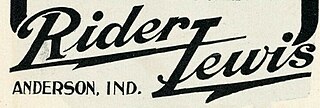
Maxwell was an American automobile manufacturer which ran from about 1904 to 1925. The present-day successor to the Maxwell company was Chrysler, now Stellantis North America, which acquired the company in 1925.

The Brass Era is an American term for the early period of automotive manufacturing, named for the prominent brass fittings used during this time for such features as lights and radiators. It is generally considered to encompass 1896 through 1915, a time when cars were often referred to as horseless carriages.
The American Chocolate later known as Walter was an American-assembled automobile. Manufactured from 1902 to 1906 by vending machine company the American Chocolate Machinery Co., in Manhattan, New York, owned by William Walter. He decided to expand his business by assembling automobiles in his factory. The cars were exhibited at the New York automobile show.

A high wheeler is a car which uses large diameter wheels that are similar to those used by horse-drawn vehicles. These cars were produced until about 1915, predominantly in the United States.

Single Center Spring Buggy Company was an American carriage and automobile manufacturer based in Evansville, Indiana. The Single Center factory manufactured the Zentmobile, Zent, Windsor, Worth, Single Center, Evansville, Simplicity and Traveler automobiles from 1903 to 1910.

John Mohler Studebaker was the Pennsylvania Dutch co-founder and later executive of what would become the Studebaker Corporation automobile company. He was the third son of the founding Studebaker family, and played a key role in the growth of the company during his years as president, from 1868 until his death in 1917.

John William Lambert was an American automobile manufacturer pioneer and inventor. He is the inventor of the first practical American gasoline automobile. He operated large manufacturing companies that made transmissions, stationary gas engines, farm tractors, commercial motor trucks, railroad inspection vehicles, and various gasoline driven street cars. He had over 600 patents. In 1891, he built a working gasoline automobile, one year before the Duryea Brothers constructed theirs.

The Union automobile was a vehicle manufactured by the Union Automobile Company from 1902 until 1905. It was designed by John William Lambert, who had developed the three-wheel Buckeye gasoline buggy in 1891. Over the next decade, Lambert substantially refined the vehicle, with modifications including an additional wheel, a more powerful engine, and a new transmission system. The Union Automobile Company was formed as a subsidiary of Lambert's Buckeye Manufacturing Company solely to manufacture the Union, which took its name from Union City, Indiana, the city where it was built and which endorsed its production. In total, the company built over three hundred Union automobiles, before development shifted to the Lambert automobile, the Union's successor.

The Lambert automobile and Lambert truck were vehicles built from 1905 through 1916 by the Lambert Automobile Company in Anderson, Indiana, United States. The Lambert automobile was an outgrowth from the Union automobile made by the Union Automobile Company, a previous vehicle that was being manufactured by John William Lambert. The factory manufactured about 3,000 automobiles and trucks per year by 1915 and had several models ranging in price from $1,200 to $3,000 at the time. The vehicles came with a gearless friction drive transmission. The demise of the manufacture of automobiles and trucks came about because of World War I.

The Lambert Automobile Company developed as a 300,000-square-foot (28,000 m2) automobile factory in Anderson, Indiana. It manufactured the Lambert automobile, truck, fire engine and farm tractor as a part of the governing Buckeye Manufacturing Company. Lambert manufactured vehicles from 1905 to 1915. In 1910 the company had over a thousand employees, and from 1910 to 1915 the production had reached about three thousand vehicles per year. It went out of business in 1917 because of World War I.
At least two different cars have been offered with the marque of Fuller, one in Nebraska and one in Michigan.

Nyberg was the name of a brass era American automobile built by Henry Nyberg of Chicago, Illinois, in Anderson, Indiana, and Chattanooga, Tennessee from 1911 to 1914.

The Riker was a veteran and brass era electric car founded in 1898 in Elizabeth, New Jersey. Designed by Andrew L. Riker, they were built in small numbers until the company was absorbed by the Electric Vehicle Company in 1901.

The Red Bug, later marketed as the Auto Red Bug were a vintage era cyclecar automobile manufactured by the Automotive Electric Service Corp. of North Bergen, New Jersey from 1924 to 1930. It is considered an early version of a microcar.

The Buckeye gasoline buggy, also known as the Lambert gasoline buggy, was an 1891 gasoline automobile, the first made in the United States. It was also the first automobile made available for sale in the United States. It was initially a three wheel horseless carriage, propelled by an internal combustion gasoline engine; it was later developed into a four-wheel automobile with a gearless transmission, and mass-produced during the first part of the twentieth century. The platform was later expanded into a line of trucks and fire engines.

The Union Automobile Company was an automobile factory to manufacture the Union automobile through the Buckeye Manufacturing Company. It began manufacturing automobiles in 1902 and produced them through 1905. The company was located in Union City, Indiana. The inventor of Union automobile gasoline engine and friction drive gearless transmission was John W. Lambert. In the early part of 1905 the company moved to Anderson, Indiana. It had produced 325 automobiles before going out of business in the later part of 1905. It was replaced with a redesigned model that became the Lambert automobile.
Charles H. Black was an American carriage maker and automobile pioneer whose business was in Indianapolis, Indiana.

Rider-Lewis was a brass era automobile built first in Muncie and then Anderson, Indiana from 1908 to 1911.
The Canda Manufacturing company based in Carteret, New Jersey, produced cars from 1900-1902.















